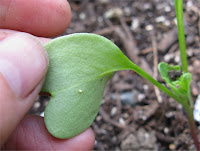It's a late summer here, so I consider this the end of spring, and there are a lot of springtime shenanigans happening in the garden.
Number one enemy is waffling between slugs and cabbage moths. My attempts to get on top of the slug problem - by setting nifty little beer traps for them in old drinks cups - are foiled by an unknown midnight visitor (raccoon seems to be the candidate of choice) who gets downright cranky if it can't get the lids off. Great, a furred vandal with a drinking problem. As if I don't have enough problems in the plague garden.

The cabbage moths are about to drive me to near-chemical control methods. They have denuded my defenseless broccoli

with their evil eggs

which hatch into evil, hungry worms

which get large on my brassicas

and leave evidence of their digestive successes. The moderately good news is that it's highly nutritious for what's left of the plants.

The options of choice for dealing with this monster are: yellow sticky traps for the moths, and
Btk for the offspring. As I saw a moth fluttering around this morning, so shall it be.
Also destined for yellow sticky traps are the evil
leafminer flies who lay their evil eggs which hatch into evil offspring who tunnel between the layers of leaves - of spinach, chard, beets, sorrel...

(note worm-like shape eating its way downwards in bottom right: this is why you might not want to eat mined leaves) you name it; even beans this year.

Because they are within the leaves you can't do much except take the leaves off and drown the occupants in your slug bucket. But the yellow sticky traps (and/or
neem oil) are said to be all you can do about the adults. The other advice - cover seedlings with row cover - is not an option at this stage of my plants' lives. And what an ugly garden that creates anyway, shrouded in
reemay.
Slugs have been busy procreating in my garden:

Last night's hunt yielded a total of 61 babes from one half-wine-barrel planter. Now deceased. 61 fewer appetites to skeletonize my hapless plants.

It's a bad year for beans in my garden; those that have not been eaten alive are developing some nasty ailment that
might be rust
- very bad news if it is. Not so bad if it afflicts, as it does, my garlic

as it won't affect the bulb. But with beans, it discolours and stunts the pods, apparently. Can't wait to find out. My fellow gardeners shake their heads and tut about beans, and most other things, saying "it's just too cold this year". I may have to give up on that bed and try to plant something else for a winter garden. Hmm. What doesn't mind being overshadowed by a giant pea trellis in an already dark garden?

There are successes to report. I've managed to stay on top of the aphids this year

and the parasitic wasps are getting the tent caterpillars under control.

Tomatoes have not yet expired from lack of sun, and a few are even setting fruit

while the volunteer potatoes are happy enough to be in sore need of hilling up

So far the aphids are not getting the better of the favas, as they did last year

and the blueberries are abundant. Soon I will cage them in hopes of foiling the birds.

The apple crop is looking awesome

and the fennel is surviving, and so is the garden supervisor.





























